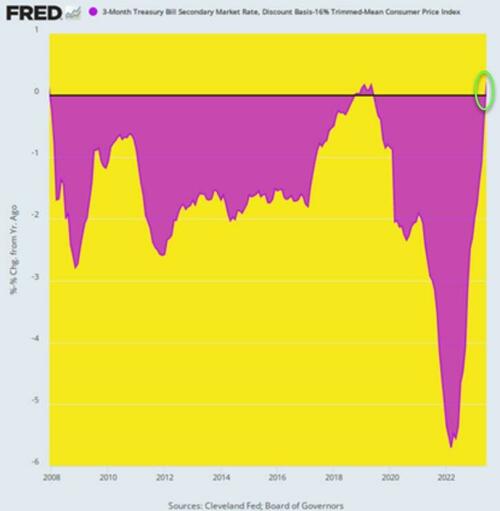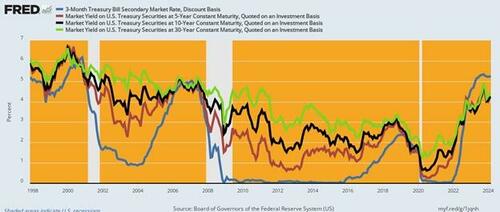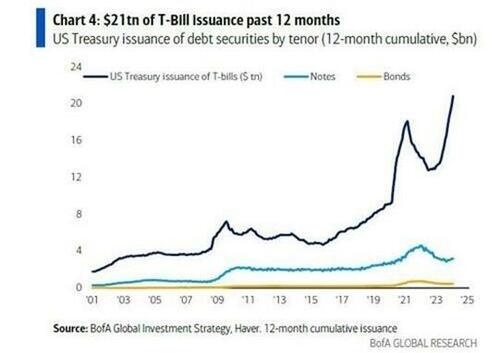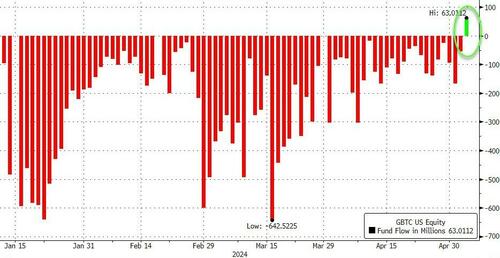Governments Cause Inflation And Hurt Bond Investors
Authored by Daniel Lacalle,
The Fed’s preferred inflation measure rose 2.8% in March from a year ago. This is the core personal consumption expenditures price index, excluding food and energy, which should be less volatile than the consumer price index and a better indicator of the real process of disinflation.

This figure is not only concerning, considering the propaganda that repeats that the fight against inflation is nearing its conclusion, but it becomes even more so when we observe the upward trend over the last three and six months. Inflation has accelerated on a quarterly and half-year basis.
As E.J. Anthony, PhD economist, points out, “there was never any indication we were heading to the 2.0% inflation target, let alone the pre-pandemic 1.8% average; we’ve arrived at 3%+ with no indication we’re going significantly lower anytime soon, not with the current levels of Treasury borrowing and Fed allowing money supply growth.”
We need to understand why inflation is not falling as promised and announced.
There is no such thing as cost-push inflation
Fiscal policy has been reckless, and enormous deficit spending is fueling inflationary pressures through unnecessary government consumption of newly created currency.
Government spending is printing new units of currency and inflation is caused by issuing more than what the private sector demands, thus making the purchasing power of money decline.
There is no such thing as cost-push inflation, greedflation, or commodity inflation.
None of those factors can make aggregate prices rise, consolidate, and continue increasing on an annualized level.
Furthermore, if cost-push or supply chain disruptions were the cause of inflation, we would have deflation today, not rising aggregate prices every month.
Governments created the inflation burst of 2021 and have not only ignored fiscal responsibility but, in the case of the United States, maintained a completely unhealthy and unrequired budget deficit
Governments are destroying the purchasing power of money and perpetuating inflation. They created the inflation burst of 2021 and have not only ignored fiscal responsibility but, in the case of the United States, maintained a completely unhealthy and unrequired budget deficit.
“An upsurge in money growth preceded the inflation flare-up, and countries with stronger money growth saw markedly higher inflation,” concluded Claudio Borio in a scholar paper in 2023 (“Does money growth help explain the recent inflation surge?”, BIS Bulletin No. 67, January 26, 2023).
Doctors Juan Castañeda and Tim Congdon already warned as early as June 2020 that “the policy reaction to the COVID-19 pandemic will increase budget deficits massively in the world’s leading countries. The deficits will largely be monetized, with heavy state borrowing from both national central banks and commercial banks. The monetization of budget deficits, combined with official support for emergency bank lending to cash-strained corporates, is leading to extremely high growth rates of the quantity of money,” and these “will instigate an inflationary boom” (Inflation: The Next Threat? Institute of Economic Affairs, Briefing 7, June 2020).
Inflation is a policy
Inflation is not a coincidence or a fatality; it is a policy. Governments tend to announce large-scale spending programs to combat inflation.
These policies accelerate money velocity in a recovery, particularly after a shutdown like the one of 2020, as well as the quantity of money in the system.
Thus, inflation rises rapidly. The only way to contain the inflation burst is to cut spending and reduce the quantity and growth of money. However, although central banks have announced so-called restrictive policies, reality has shown the opposite.
The quantity of money in the system has not been reduced. Money supply measured as M2 has declined, and the balance sheet of the Federal Reserve has diminished, but these forces have been entirely offset by net liquidity and money market funds.
As government spending and deficit have not fallen at all, but rather the opposite, the economy has been flooded with the post-waves of the first money growth impact (2020), its market and net liquidity effect, and rising public expenditure with annual deficits close to $2 trillion.
The quantity of money has not been reduced
The Federal Reserve has increased rates, but that only helps moderate the growth of money, not eliminate inflationary pressures.
Furthermore, as markets immediately discounted large rate cuts in 2024, the real effect on money growth has been just to postpone the inevitable future monetization of such enormous deficits. It has become a Call option on a forthcoming new quantitative easing program.
We cannot forget that the quantity of money has not been reduced due to another relevant factor.
The Federal Reserve has multiplied its support for the troubled banking sector via the discount window, which offsets the modest reduction in the Fed balance sheet.
Instead of attacking inflation, the so-called “Inflation Reduction Act” has perpetuated the destruction of the value of the currency issued
By purchasing the sovereign bonds in the banks’ balance sheets at par despite the collapse in price, the Fed was inadvertently printing new money and sabotaging its own restrictive measures.
The misguided Keynesian policies implemented by the US government have cancelled out the Federal Reserve’s balance sheet reduction and rate hike efforts.
The Treasury injected more than $2 trillion per annum in liquidity, creating new money, counteracting the net $1.6 trillion that the Fed retired in three years from its balance sheet.
Therefore, the impact on the purchasing power of the currency through inflation has been negative. Instead of attacking inflation, the so-called “Inflation Reduction Act” has perpetuated the destruction of the value of the currency issued.
The impact on markets
The impact on markets has been phenomenal. The yen, once a stable currency perceived as a haven for investors, has fallen to a 35-year low versus the US dollar.
The Bloomberg index of globally expanded major currencies and the emerging markets indicator have both fallen.
The result of the 2020–2024 “free money” wave was a very expensive destruction of real wages and deposit savings.
Furthermore, bonds have been obliterated and the latest data shows that the aggregate US and euro area bond indices have not recovered from the past years’ slump, and even going back to 2020, the indices are showing negative returns.
Only the high yield index has shown a positive performance in the past four years, albeit a meager 4.5%.
Governments are destroying the currency that they issue in all possible ways. Through persistent inflation, making wage earners and middle-class deposit savers poorer, with rising taxes to try to reduce a budget deficit that was bloated by unnecessary spending in a recovery, and through the destruction of the safest asset, bonds, that have become a bad investment for the most conservative investors, pension funds.
The only way in which inflation will be reduced will be if the Federal Reserve abandons its decision to cut rates and starts to take measures that drain net liquidity.
Without the support of the Treasury, this is impossible because it floods the market with new money even if monetary policy is restrictive and investors simply discounts that all those newly issued currency units will be monetized somehow in the future.
It does not matter if Powell promises restraint when Yellen pushes excess. The most conservative bondholders will only start to see positive returns when the Treasury stops destroying the currency’s value. It does not seem likely anytime soon.
Tyler Durden
Sat, 05/04/2024 - 16:20





 AFP via Getty Images
AFP via Getty Images (Illustration by The Epoch Times, The Cass Review, Getty Images, Freepik)
(Illustration by The Epoch Times, The Cass Review, Getty Images, Freepik) The NHS Tavistock Centre, England's first gender-identity development service for children, in London on April 10, 2024. (Henry Nicholls/AFP via Getty Images)
The NHS Tavistock Centre, England's first gender-identity development service for children, in London on April 10, 2024. (Henry Nicholls/AFP via Getty Images) A young girl at the annual NYC Pride March in New York City on June 25, 2023. (Samira Bouaou/The Epoch Times)
A young girl at the annual NYC Pride March in New York City on June 25, 2023. (Samira Bouaou/The Epoch Times) A Tel Aviv demonstrator holds an Israeli flag during a Ukraine-related protest, AFP via Getty Images
A Tel Aviv demonstrator holds an Israeli flag during a Ukraine-related protest, AFP via Getty Images
 Via
Via  A man received a dose of the Pfizer COVID-19 vaccine at the Amazon Meeting Center in downtown Seattle, on Jan. 24, 2021. (Grant Hindsley/AFP via Getty Images)
A man received a dose of the Pfizer COVID-19 vaccine at the Amazon Meeting Center in downtown Seattle, on Jan. 24, 2021. (Grant Hindsley/AFP via Getty Images)
 AFP via Getty Images
AFP via Getty Images











 Emir Tamim bin Hamad al-Thani (R) in a meeting with Hamas official Khaled Mashal in Doha, Qatar govt handout
Emir Tamim bin Hamad al-Thani (R) in a meeting with Hamas official Khaled Mashal in Doha, Qatar govt handout





 US Navy personnel construct a ‘Joint Logistics Over-the Shore’ temporary pier. Image: CENTCOM via Reuters
US Navy personnel construct a ‘Joint Logistics Over-the Shore’ temporary pier. Image: CENTCOM via Reuters
 Picture Alliance via Getty Images
Picture Alliance via Getty Images
Recent comments